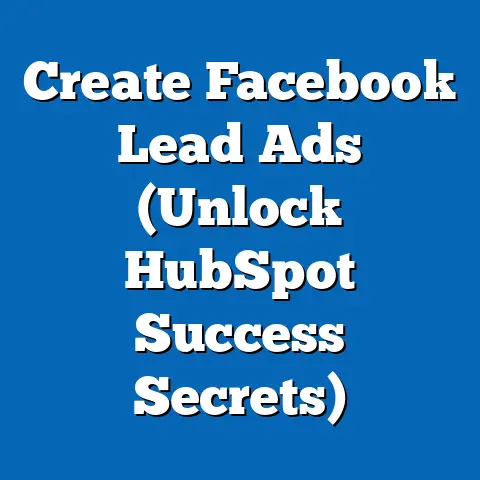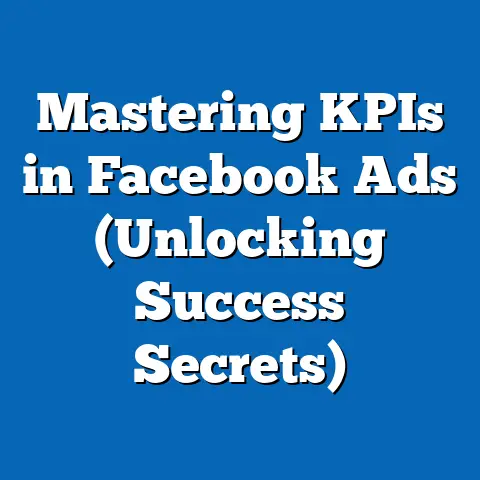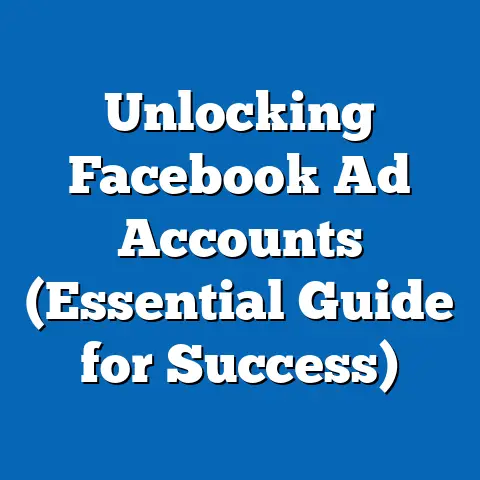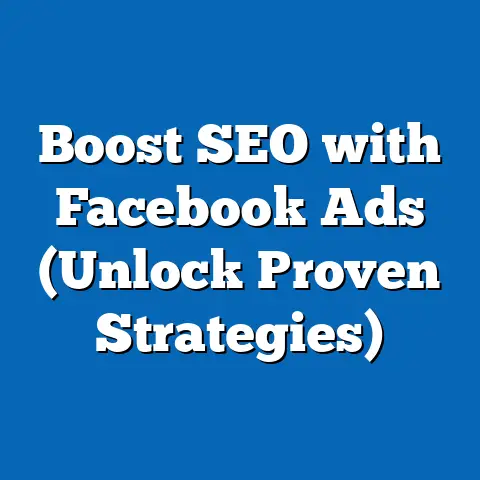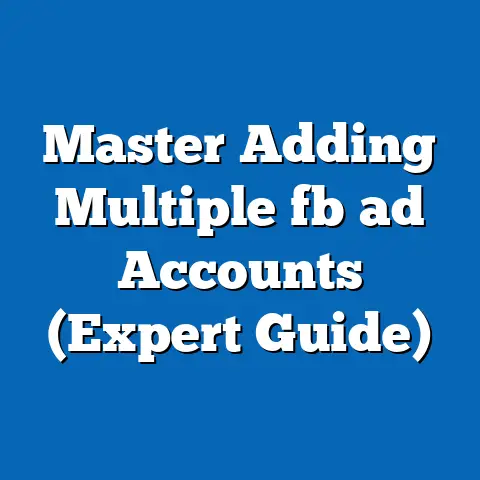Master Facebook Ad Components (Essential Strategies Revealed)
Did you know that Facebook Ads, as of 2023, have been shown to deliver an average ROI of 4,000%? That’s right, for every dollar spent, businesses can expect to earn $40 in return. This staggering figure isn’t just a random statistic; it’s a testament to the power and potential of Facebook advertising when executed correctly. Mastering the components of Facebook ads is no longer an option but a necessity for businesses, marketers, and entrepreneurs looking to leverage this platform for explosive growth.
Understanding the Basics of Facebook Ads
Let’s start with the fundamentals. What exactly are Facebook Ads, and why are they so crucial in today’s digital marketing landscape?
Facebook Ads are paid advertisements that appear on Facebook, Instagram, Messenger, and the Audience Network. They allow businesses to target specific demographics, interests, and behaviors, making them incredibly powerful for reaching potential customers.
Importance in Digital Marketing:
In a world saturated with information, cutting through the noise is a constant challenge. Facebook Ads provide a direct line to your target audience, allowing you to deliver personalized messages that resonate with their needs and interests.
The Facebook Advertising Ecosystem:
Understanding the difference between organic reach and paid ads is fundamental. Organic reach refers to the number of people who see your content without any paid promotion. Due to algorithm changes, organic reach on Facebook has declined significantly over the years. Paid ads, on the other hand, guarantee visibility to your target audience, making them an essential tool for driving traffic, generating leads, and increasing sales.
Key Components We’ll Cover:
In this guide, we will delve into the following essential components:
- Targeting: Identifying and reaching the right audience for your ads.
- Ad Format: Choosing the most effective ad format for your campaign goals.
- Creative Elements: Crafting compelling headlines, ad copy, images, and calls to action.
- Performance Measurement: Tracking and analyzing ad performance to optimize your campaigns.
Takeaway: Facebook Ads are a powerful tool for reaching a targeted audience, but understanding the basics and key components is essential for success.
Targeting Your Audience
Imagine launching a fishing net into the vast ocean. You’ll catch something, sure, but what if you could pinpoint exactly where the most valuable fish are swimming? That’s what effective audience targeting in Facebook ads does. It’s the cornerstone of any successful campaign, ensuring your message reaches the people most likely to convert.
The Significance of Audience Targeting:
Targeting isn’t just about reaching more people; it’s about reaching the right people. A well-targeted ad campaign can significantly increase your ad relevance score, lower your costs, and improve your overall ROI.
Facebook’s Targeting Options:
Facebook offers a plethora of targeting options, allowing you to narrow down your audience based on:
- Demographics: Age, gender, location, education, job title, and more.
- Interests: Hobbies, passions, and topics they follow on Facebook.
- Behaviors: Past purchase behavior, device usage, travel habits, and other actions they’ve taken online.
- Custom Audiences: Uploading your own customer lists (email addresses, phone numbers) to target existing customers or create lookalike audiences.
Strategies for Creating Buyer Personas:
Creating detailed buyer personas is essential for effective targeting. A buyer persona is a semi-fictional representation of your ideal customer based on market research and data about your existing customers.
Here’s how I create buyer personas:
- Gather Data: Analyze your existing customer base. Look at their demographics, purchase history, and online behavior.
- Conduct Interviews: Talk to your customers directly. Ask them about their needs, challenges, and motivations.
- Identify Patterns: Look for common traits and patterns in your data and interviews.
- Create a Persona: Give your persona a name, a job title, and a backstory. Describe their goals, challenges, and pain points.
Example:
- Persona Name: Marketing Manager Maya
- Job Title: Marketing Manager at a small e-commerce business
- Demographics: 30 years old, lives in Los Angeles, CA
- Goals: Increase brand awareness, drive traffic to the website, generate leads
- Challenges: Limited budget, difficulty targeting the right audience, overwhelmed by the complexity of Facebook Ads
- Pain Points: Wasting money on ineffective ads, struggling to track ROI, not enough time to manage campaigns
Leveraging Facebook’s Audience Insights Tool:
Facebook’s Audience Insights tool provides valuable data about your target audience, including their demographics, interests, and behaviors.
Here’s how I use Audience Insights:
- Define Your Audience: Start by selecting a broad audience based on demographics or interests.
- Explore Insights: Use the tool to explore their interests, page likes, location, and household information.
- Refine Your Targeting: Use the insights to refine your targeting options and create more effective ads.
Utilizing Lookalike Audiences:
Lookalike audiences allow you to reach new people who are similar to your best customers. Facebook analyzes your existing customer lists and identifies common traits and behaviors. It then finds new people who share those traits and behaviors.
Here’s how I create lookalike audiences:
- Create a Custom Audience: Upload your customer list (email addresses or phone numbers) to Facebook.
- Create a Lookalike Audience: Select your custom audience as the source and choose the size of your lookalike audience (1-10%).
- Target Your Ads: Target your ads to your lookalike audience.
Takeaway: Effective audience targeting is crucial for the success of your Facebook ad campaigns. Use buyer personas, Facebook’s Audience Insights tool, and lookalike audiences to reach the right people with your ads.
Choosing the Right Ad Format
Think of your Facebook ad as a vehicle. The message you want to convey is the cargo. But without the right vehicle (the ad format), your message might not reach its destination effectively. Facebook offers a variety of ad formats, each with its strengths and weaknesses. Choosing the right one is critical for achieving your campaign goals.
Ad Formats Available on Facebook:
- Image Ads: Single image with text. Simple, effective, and great for showcasing products or services.
- Video Ads: Short videos that capture attention and tell a story. Ideal for brand awareness and driving engagement.
- Carousel Ads: Multiple images or videos that users can swipe through. Perfect for showcasing multiple products or features.
- Slideshow Ads: Create a video-like experience with static images. Cost-effective and easy to produce.
- Collection Ads: A combination of images and videos designed for mobile shopping. Ideal for e-commerce businesses.
Strengths and Weaknesses of Each Format:
| Ad Format | Strengths | Weaknesses | Use Cases |
|---|---|---|---|
| Image Ads | Simple, cost-effective, easy to create | Can be less engaging than video | Showcasing products, driving traffic to a website, generating leads |
| Video Ads | Highly engaging, great for storytelling, can drive high conversion rates | More expensive to produce, requires more planning | Brand awareness, product demos, testimonials, driving sales |
| Carousel Ads | Showcasing multiple products, telling a story, driving traffic to multiple pages | Can be overwhelming if not well-designed | E-commerce businesses, real estate, travel, showcasing product features |
| Slideshow Ads | Cost-effective, easy to create, great for mobile | Can be less engaging than video | Showcasing products, telling a story, driving traffic to a website |
| Collection Ads | Designed for mobile shopping, visually appealing, drives direct sales | Requires a product catalog, can be more complex to set up | E-commerce businesses, retailers, driving direct sales |
| Ad Format | Strengths | Weaknesses | Use Cases |
|---|---|---|---|
| Image Ads | Simple, cost-effective, easy to create | Can be less engaging than video | Showcasing products, driving traffic to a website, generating leads |
| Video Ads | Highly engaging, great for storytelling, can drive high conversion rates | More expensive to produce, requires more planning | Brand awareness, product demos, testimonials, driving sales |
| Carousel Ads | Showcasing multiple products, telling a story, driving traffic to multiple pages | Can be overwhelming if not well-designed | E-commerce businesses, real estate, travel, showcasing product features |
| Slideshow Ads | Cost-effective, easy to create, great for mobile | Can be less engaging than video | Showcasing products, telling a story, driving traffic to a website |
| Collection Ads | Designed for mobile shopping, visually appealing, drives direct sales | Requires a product catalog, can be more complex to set up | E-commerce businesses, retailers, driving direct sales |
Use Cases for Different Business Goals:
- Brand Awareness: Video ads and slideshow ads are excellent for telling your brand story and increasing brand recognition.
- Lead Generation: Image ads and carousel ads with strong calls to action can drive traffic to lead capture pages.
- Conversions: Collection ads and carousel ads are ideal for showcasing products and driving direct sales.
The Importance of A/B Testing:
A/B testing involves creating two or more versions of an ad and testing them against each other to see which performs better. This is crucial for determining which ad format resonates best with your target audience.
Here’s how I A/B test ad formats:
- Create Two Versions: Create two versions of your ad with different ad formats (e.g., image ad vs. video ad).
- Target the Same Audience: Target both versions to the same audience.
- Track Performance: Monitor the performance of each version and track key metrics like click-through rate (CTR) and conversion rate.
- Analyze Results: Analyze the results and determine which ad format performs better.
- Optimize: Use the results to optimize your campaigns and focus on the ad format that delivers the best results.
Staying Updated with Facebook’s Evolving Ad Formats:
Facebook is constantly evolving and introducing new ad formats. Staying updated with these changes is essential for maximizing your advertising effectiveness.
Here’s how I stay updated:
- Follow Facebook’s Business Blog: Stay informed about the latest updates and features.
- Join Industry Groups: Connect with other marketers and share insights.
- Attend Webinars: Learn from industry experts and stay up-to-date with the latest trends.
Takeaway: Choosing the right ad format is essential for achieving your campaign goals. Consider the strengths and weaknesses of each format, A/B test different options, and stay updated with Facebook’s evolving ad formats.
Crafting Compelling Creative Elements
Your ad’s creative elements are like the bait on a fishing hook. They need to be irresistible to your target audience. Compelling headlines, ad copy, images, and calls to action (CTAs) are the key to capturing attention and driving action.
Essential Creative Components:
- Headlines: The first thing people see. It needs to be attention-grabbing and relevant to your audience.
- Ad Copy: The text that accompanies your ad. It should be clear, concise, and persuasive.
- Images: Visuals that capture attention and convey your message. They should be high-quality and relevant to your ad.
- Calls to Action (CTAs): Buttons or links that prompt users to take a specific action (e.g., “Learn More,” “Shop Now,” “Sign Up”).
Best Practices for Writing Engaging Ad Copy:
- Know Your Audience: Understand their needs, challenges, and motivations.
- Highlight Benefits: Focus on the benefits of your product or service, not just the features.
- Use Clear and Concise Language: Avoid jargon and technical terms.
- Create a Sense of Urgency: Use words like “limited time offer” or “shop now” to encourage immediate action.
- Tell a Story: Engage your audience with a compelling narrative.
Example of Effective Ad Copy:
Headline: Tired of Wasting Money on Ineffective Ads?
Ad Copy: Discover the secret to Facebook advertising success! Our expert strategies will help you target the right audience, craft compelling ads, and track your ROI. Get started today and start seeing results!
The Role of Visuals in Facebook Ads:
Visuals are crucial for capturing attention and conveying your message. High-quality images or videos can significantly increase the effectiveness of your ads.
Tips for Selecting High-Quality Images or Videos:
- Use Professional-Quality Images: Avoid blurry or pixelated images.
- Choose Relevant Images: Ensure your images are relevant to your ad copy and target audience.
- Use Eye-Catching Visuals: Use bright colors, interesting compositions, and engaging subjects.
- Maintain Branding Consistency: Use your brand colors, fonts, and logo in your visuals.
The Impact of CTAs:
CTAs are the final nudge that prompts users to take action. Choosing the right CTA can significantly impact your conversion rates.
How to Choose the Right CTA:
- Consider Your Campaign Objectives: What action do you want users to take?
- Use Action-Oriented Language: Use words like “Learn More,” “Shop Now,” “Sign Up,” or “Get Started.”
- Make It Visually Appealing: Use a button with a contrasting color to make it stand out.
- A/B Test Different CTAs: Test different CTAs to see which performs better.
Takeaway: Compelling creative elements are essential for capturing attention and driving action. Craft engaging ad copy, use high-quality visuals, and choose the right CTAs to maximize the effectiveness of your Facebook ads.
Performance Measurement and Optimization
You’ve launched your Facebook ad campaign, but the journey doesn’t end there. Tracking and analyzing ad performance is crucial for ensuring the success of your campaigns and maximizing your ROI. It’s like charting a course on a ship – without knowing where you are, you can’t reach your destination.
Significance of Tracking and Analyzing Ad Performance:
Tracking ad performance allows you to identify what’s working and what’s not. By analyzing key metrics, you can optimize your campaigns, improve your targeting, and refine your creative elements.
Key Performance Indicators (KPIs) Relevant to Facebook Ads:
- Click-Through Rate (CTR): The percentage of people who click on your ad after seeing it. A high CTR indicates that your ad is relevant and engaging.
- Conversion Rate: The percentage of people who take a desired action (e.g., make a purchase, sign up for a newsletter) after clicking on your ad. A high conversion rate indicates that your landing page is effective.
- Cost Per Acquisition (CPA): The cost of acquiring a new customer through your ad campaign. A low CPA indicates that your campaign is efficient.
- Return on Ad Spend (ROAS): The amount of revenue generated for every dollar spent on advertising. A high ROAS indicates that your campaign is profitable.
Tools Available on Facebook for Monitoring Ad Performance:
- Ads Manager: Facebook’s primary tool for managing and tracking ad performance. It provides detailed data on your campaigns, ad sets, and ads.
- Facebook Analytics: A tool for tracking user behavior on your website and app. It provides insights into how people interact with your content and products.
Actionable Strategies for Optimizing Campaigns Based on Performance Data:
- Adjust Targeting: If your ads aren’t reaching the right people, adjust your targeting options. Experiment with different demographics, interests, and behaviors.
- Reallocate Budget: If some ad sets are performing better than others, reallocate your budget to the higher-performing ad sets.
- Refine Creative Elements: If your ads aren’t capturing attention, refine your headlines, ad copy, and visuals. A/B test different options to see which performs better.
- Improve Landing Page: If your conversion rate is low, improve your landing page. Make sure it’s relevant to your ad, easy to navigate, and optimized for conversions.
Takeaway: Tracking and analyzing ad performance is crucial for the success of your Facebook advertising campaigns. Use KPIs, Facebook’s Ads Manager, and Facebook Analytics to monitor your performance and optimize your campaigns based on the data.
Staying Ahead of the Curve
The world of Facebook advertising is constantly evolving. New features, algorithm updates, and changing consumer behaviors can impact the effectiveness of your campaigns. Staying ahead of the curve is essential for maintaining a competitive edge and maximizing your ROI.
Importance of Staying Updated:
What worked yesterday may not work today. Facebook is constantly changing its algorithm, introducing new features, and updating its policies. Staying informed about these changes is crucial for adapting your strategies and maximizing your advertising effectiveness.
Resources for Continuous Learning:
- Industry Blogs: Follow industry blogs like Social Media Examiner, AdEspresso, and Jon Loomer Digital to stay updated on the latest trends and best practices.
- Facebook’s Blueprint Courses: Take Facebook’s Blueprint courses to learn about the platform’s advertising features and best practices.
- Community Groups: Join Facebook groups and online communities to connect with other marketers and share insights.
Adapting to Changes in Consumer Behavior:
Consumer behavior is constantly evolving. What people want and how they interact with ads is always changing. Staying attuned to these shifts is key.
Here’s how I adapt:
- Monitor Trends: Keep an eye on social media trends and industry reports.
- Analyze Your Data: Track how your audience is responding to your ads and adjust your strategies accordingly.
- Experiment with New Features: Be willing to try new ad formats and targeting options.
Adapting to Algorithm Updates:
Facebook’s algorithm determines which ads are shown to users. Understanding how the algorithm works and how it changes is crucial for maximizing your reach and engagement.
Here’s how I adapt to algorithm updates:
- Stay Informed: Follow Facebook’s announcements and industry blogs to stay updated on algorithm changes.
- Focus on Quality Content: Create high-quality, engaging content that resonates with your audience.
- Optimize for Engagement: Encourage users to like, comment, and share your ads.
Takeaway: Staying ahead of the curve is essential for the success of your Facebook advertising campaigns. Stay updated with the latest trends, algorithm updates, and changes in consumer behavior.
Conclusion
Mastering Facebook ad components is not just about understanding the platform; it’s about understanding people, their behaviors, and their needs. By effectively utilizing targeting, ad formats, creative elements, and performance measurement, businesses can maximize their advertising effectiveness on one of the world’s largest social media platforms.
Remember, Facebook advertising is an ongoing process of learning, testing, and optimizing. Stay curious, stay informed, and never stop experimenting. The potential for growth and success on Facebook is immense, and with the right strategies, you can unlock that potential for your business.
So, take what you’ve learned here, apply it to your campaigns, and watch your results soar. The world of Facebook advertising awaits, and with these essential strategies, you’re now equipped to conquer it.


